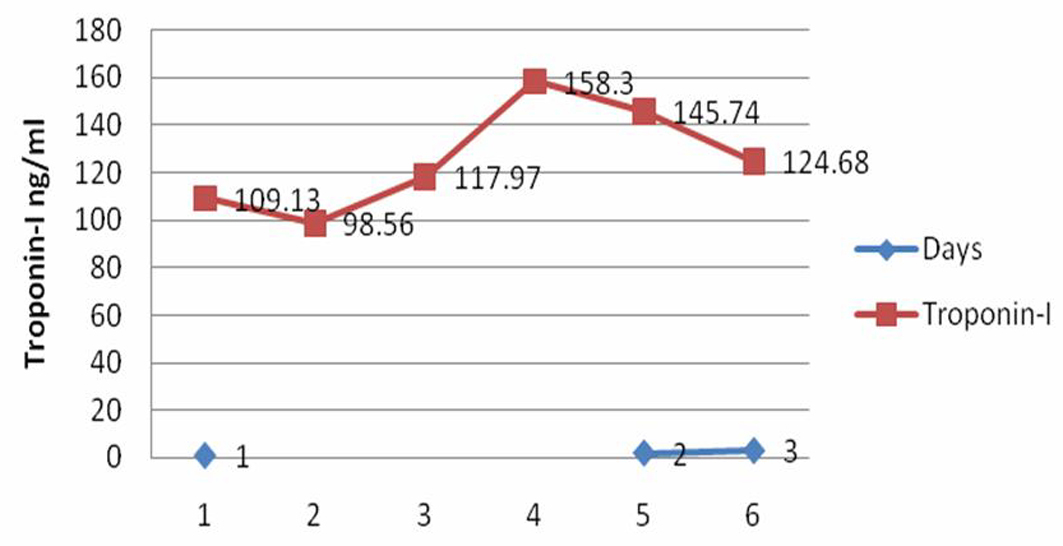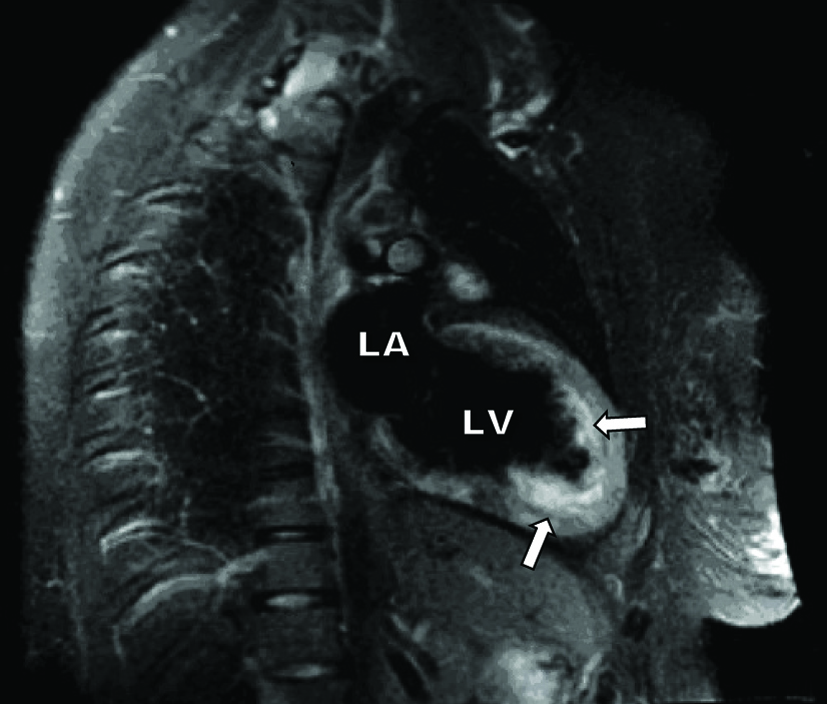| Cardiology Research, ISSN 1923-2829 print, 1923-2837 online, Open Access |
| Article copyright, the authors; Journal compilation copyright, Cardiol Res and Elmer Press Inc |
| Journal website http://www.cardiologyres.org |
Case Report
Volume 2, Number 3, June 2011, pages 123-126
Markedly Elevated Cardiac Bio-Markers at Presentation With Normal Ventricular Function: A Novel Clinical Subset of Myocarditis Manifestation
Amruth R Pallaa, d, Siva Sontinenib, Susan Manic
aDanbury Hospital, Department of Internal Medicine, USA
bCreighton University School of Medicine, Department of Cardiology, USA
cDanbury Hospital, Department of Cardiology, USA
dCorresponding author: Amruth Palla, 6221, Avalon Valley Drive, Danbury, CT-06810, USA
Manuscript accepted for publication March 5, 2011
Short title: Markedly Elevated Cardiac Bio-Markers in Myocarditis
doi: https://doi.org/10.4021/cr15w
| Abstract | ▴Top |
We present a case of a 19-year-old woman with myocarditis who had significantly elevated cardiac markers at presentation even before any myocardial damage ensued. The patient had complicated clinical course with ventricular arrhythmia and cardiac arrest requiring resuscitation but eventually recovered completely. Though there is limited information available regarding such cases, the significantly elevated initial cardiac markers in the absence of left ventricular decompensation may probably represent a clinical subset of myocarditis and may portend an impending complicated clinical course. Further systematic research is required to define the clinical phenotype and elucidate underlying mechanisms.
Keywords: Myocarditis; Cardiac troponins; Congestive heart failure; Arrhythmia
| Introduction | ▴Top |
Myocarditis is a commonly diagnosed condition and its patho-physiology is well known. However it is very rare to see a significant elevation of cardiac markers to the extent of troponin I > 100 ng/ml in the early initial phase of the disease especially in the absence of any LV decompensation.
| Case Report | ▴Top |
A 19-year-old woman presented with dry cough, shortness of breath, and pleuritic chest pain for 2 days. She denied fever, chills or other associated symptoms. She did not travel recently or have any sick contacts. Her past medical history was unremarkable and has had all recommended immunizations as a child. Her only medications included oral contraceptive pills. She did not smoke or abuse alcohol. Her family history was significant for myocarditis in her sister and her paternal aunt at around the same age.
The various patient parameters during the clinical course of this illness are outlined in Table 1.
 Click to view | Table 1. Various Clinical Parameters of the Case |
The troponin I was markedly elevated at presentation and during the first few days of hospital course (Fig. 1). Further troponin levels were not obtained during the clinical course.
 Click for large image | Figure 1. Trend of troponin-I over days of myocarditis hospitalization. |
She had frequent premature ventricular complexes and was treated with Metoprolol. On day three she had ventricular fibrillation and suffered cardiac arrest with successful defibrillation and resuscitation. She was treated with 450 mg of intravenous Amiodarone and required mechanical ventilation. On echocardiogram, the left ventricular ejection fraction has decreased to 20 - 25% (60 - 65% at admission). The patient was transferred to tertiary care center for further management. Cardiac catheterization showed no evidence of coronary artery disease. Endomyocardial biopsy showed myocytes with no specific diagnostic abnormality and a Congo red stain was negative. MRI with T2 weighted and viability/scar imaging revealed diffuse circumferential, abnormal mid-myocardial and basilar epicardial edema and abnormal myocardial enhancement consistent with myocarditis (Fig. 2). Repeat MRI showed improving myocarditis. The left ventricular ejection fraction improved to 45% on pre-discharge echocardiogram 7 days after presentation. Patient was tapered off the Amiodarone therapy and remained stable in sinus rhythm. Patient was discharged only on Carvedilol (6.25 mg twice daily) and her course was uneventful on follow up at two and six months post discharge. The left ventricular ejection fraction has improved to 55% (at 6 months) on repeat echocardiographic evaluation.
 Click for large image | Figure 2. Sagital view of the heart on Cardiac MRI with T2 weighted and viability/scar imaging showing diffuse circumferential, abnormal myocardial enhancement consistent with myocarditis of the left ventricle (shown by arrows). |
| Discussion | ▴Top |
Myocarditis is the inflammation of the myocardium with necrosis of the myocytes in the absence of ischemia, predominantly confined to subepicardial with less frequent involvement of midwall or transmural myocardium. Myocarditis is a manifestation of etiologies such as infections, radiation, hypersensitivity, trauma, chemical and physical agents. It can either be focal or diffuse and has varied clinical presentations with a mild chest pain lasting for a few days and resolving completely without any consequences in its mildest form, to a stormy clinical course complicated by various types of malignant arrhythmias and progression to a fulminant form characterized by acute congestive heart failure requiring management with extra corporeal membrane oxygen and cardiac transplantation to death in its severe form [1-3].
Cardiac biomarkers are elevated in about one-third of patients with acute myocarditis [4, 5] and are of help in making the clinical diagnosis [6]. Elevation of cardiac Troponin I is more common than creatine kinase MB as seen from available clinical and experimental data [5]. Troponin I has limited sensitivity (34%) in the setting of acute myocarditis [7]. The degree of elevation of the cardiac markers in acute myocarditis is directly proportional to the degree of myocardial damage, i.e., less in focal compared to diffuse form [8] and more in fulminant than in non-fulminant cases [1]. For the same reason the degree of cardiac enzyme elevation is less in the initial stages of the disease and worsens during the clinical course with greater myocardial tissue necrosis.
Marked elevation of troponin levels at presentation, especially in the absence of any evidence of left ventricular dysfunction is unusual in the clinical course of myocarditis. Our patient had troponin levels greater than 100 ng/ml at presentation with normal vital signs and left ventricular ejection fraction (Table 2).
 Click to view | Table 2. Left Ventricular Internal Diameters at Various Points During the Hospital Course |
Initial troponin levels in myocarditis within twelve hours of presentation of only as high as ∼ 50 ng/ml was reported in various published articles [8-15] with a wide range (< 1 to 48.5 and a mean of 12.25 ng/ml). The peak troponin level even in fulminant forms of myocarditis was reported to be less than 50 ng/ml in majority of published reports [4, 9, 11, 12, 14, 16]. We found only one report describing the clinical course of four patients with fulminant myocarditis with troponin levels that peaked to ∼ 190 ng/ml in 3 survivors and ∼ 1200 ng/ml in the non-survivor. Unlike our patient, the markedly elevated peak troponin levels in these patients occurred during the clinical course rather than at presentation [1].
Conclusion
Myocarditis with marked elevation of cardiac biomarkers at presentation and during the early initial phase of the illness prior to left ventricular dysfunction is a rare manifestation. There is limited published literature of such cases and this may represent a specific subset of myocarditis and may portend an impending complicated clinical course. It is unknown if the clinical presentation is related to etiologic agent or susceptibility due to underlying genetic variation. The management includes close hemodynamic and electrocardiographic monitoring and initiation of prophylactic low dose of beta blockers. Malignant arrhythmias and cardiogenic shock may necessitate anti-arrhythmic therapy and/or circulatory hemodynamic support therapies. Further systematic research is required to define the clinical phenotype and elucidate underlying mechanisms.
| References | ▴Top |
- Oshima K, Kunimoto F, Hinohara H, Hayashi Y, Hirato J, Tajima Y, Kuwano H. Fulminant myocarditis treated with percutaneous cardiopulmonary support system (PCPS). Ann Thorac Cardiovasc Surg. 2008;14(2):75-80.
pubmed - Lewis GD, Holmes CB, Holmvang G, Butterton JR. Case records of the Massachusetts General Hospital. Case 8-2007. A 48-year-old man with chest pain followed by cardiac arrest. N Engl J Med. 2007;356(11):1153-1162.
pubmed - Graner M, Lommi J, Kupari M, Raisanen-Sokolowski A, Toivonen L. Multiple forms of sustained monomorphic ventricular tachycardia as common presentation in giant-cell myocarditis. Heart. 2007;93(1):119-121.
pubmed doi - Leeper NJ, Wener LS, Dhaliwal G, Saint S, Wachter RM. Clinical problem-solving. One surprise after another. N Engl J Med. 2005;352(14):1474-1479.
pubmed doi - Lauer B, Niederau C, Kuhl U, Schannwell M, Pauschinger M, Strauer BE, Schultheiss HP. Cardiac troponin T in patients with clinically suspected myocarditis. J Am Coll Cardiol. 1997;30(5):1354-1359.
pubmed doi - Cooper LT
Jr . Myocarditis. N Engl J Med. 2009;360(15):1526-1538.
pubmed doi - Smith SC, Ladenson JH, Mason JW, Jaffe AS. Elevations of cardiac troponin I associated with myocarditis. Experimental and clinical correlates. Circulation. 1997;95(1):163-168.
pubmed - Stankewicz MA, Clements SD
Jr . Fulminant myocarditis presenting with wide complex tachycardia. South Med J. 2004;97(10):1007-1009.
pubmed doi - Ammann P, Naegeli B, Schuiki E, Straumann E, Frielingsdorf J, Rickli H, Bertel O. Long-term outcome of acute myocarditis is independent of cardiac enzyme release. Int J Cardiol. 2003;89(2-3):217-222.
pubmed - Weidenbach M, Springer T, Daehnert I, Klingel K, Doll S, Janousek J. Giant cell myocarditis mimicking idiopathic fascicular ventricular tachycardia. J Heart Lung Transplant. 2008;27(2):238-241.
pubmed doi - Roongsritong C, Warraich I, Bradley C. Common causes of troponin elevations in the absence of acute myocardial infarction: incidence and clinical significance. Chest. 2004;125(5):1877-1884.
pubmed doi - Saiki A, Iwase M, Takeichi Y, Umeda H, Ishiki R, Inagaki H, Kato Y,
et al . Diversity of the elevation of serum cardiac troponin I levels in patients during their first visit to the emergency room. Circ J. 2007;71(9):1458-1462.
pubmed doi - Coudrey L. The troponins. Arch Intern Med. 1998;158(11):1173-1180.
pubmed doi - Lakkireddy DR, Kondur AK, Chediak EJ, Nair CK, Khan IA. Cardiac troponin I release in non-ischemic reversible myocardial injury from acute diphtheric myocarditis. Int J Cardiol. 2005;98(2):351-354.
pubmed doi - Tai YT, Lau CP, Fong PC, Li JP, Lee KL. Incessant automatic ventricular tachycardia complicating acute coxsackie B myocarditis. Cardiology. 1992;80(5-6):339-344.
pubmed doi - Parrillo JE. Inflammatory cardiomyopathy (myocarditis): which patients should be treated with anti-inflammatory therapy?. Circulation. 2001;104(1):4-6.
pubmed doi
This is an open-access article distributed under the terms of the Creative Commons Attribution License, which permits unrestricted use, distribution, and reproduction in any medium, provided the original work is properly cited.
Cardiology Research is published by Elmer Press Inc.











